
Locomotion and support
Dr Bbosa Science
Locomotion
One of the characteristics of living things is movement. This is obvious in animals but less obvious in the majority of plants, Movement enables animals to look for food, mates, and escape predators.
For movement to be possible there must be a form of support. In plants especially, the young one is the turgor pressure; In the old dicotyledonous plants, it’s the woody tissue while in animals it’s the skeletal tissue.
The skeleton
There are three types of skeleton
Hydrostatic skeleton
Here support is provided by a fluid under pressure and it is found in roundworms, earth. Here the coelom of the body is filled with fluid under pressure and the muscle surrounding the coelom contract against the skeleton

Movement in earthworm
The body wall of earthworm contains muscles that contract against the fluid in the coelomic body cavity, creating pressure which maintains the animal shape in much the same way as a balloon’s shape is maintained when full of air. There is two antagonistic sets of muscle tissue in the body wall; Circular and longitudinal muscle. When the circular muscles contract, the longitudinal muscles relax, the body becomes long and thin, when the longitudinal muscle contract the circular muscle relaxes the body becomes short and fat.

Transverse septa divided the body cavity into a series of watertight compartment [segment]. This means that a change in pressure in one part of the body doesn’t immediately spread to other parts, so localized bulges can occur. Locomotion is achieved by these bulges being propagated along the body.
Exoskeleton
It is made of a hard cuticle protecting inner delicate tissues and also provides attachment for muscles
Insects thorax contain two sets of antagonistic flight muscle; a pair of dorsoventral muscle (indirect muscle- not attached to the wing) run from the roof to the floor of the thorax; and a pair of longitudinal muscles run from the anterior surface of the dome-like roof to the posterior surface. When the dorsoventral muscle contract the roof attachment of the wing is pulled downwards to the wall attachment with a result that the wing goes up. When the longitudinal muscles contract the top of the dome-like roof rises slightly and the roof attachment is pulled upwards relative to the wall attachment with the result that the wing goes down.
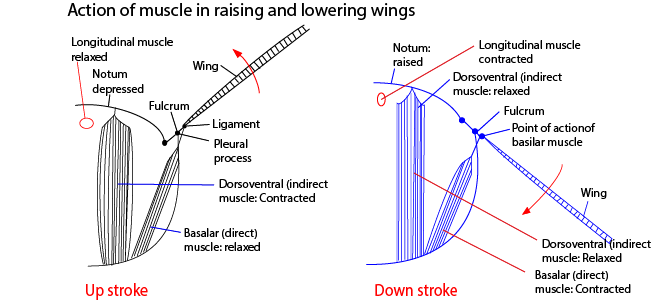
Advantage of exoskeleton
- It minimize water loss by evaporation
2. It protects the internal soft tissue
3. It determine maximum size of the organism
Disadvantage
It limits the rate of growth of the organism.
Endoskeleton
It occurs invertebrates, made of bone and cartilages.
It is internal and the muscles are outside
Advantages-
-does not interfere with the rate of growth
Disadvantage
Do not protect all soft tissue.
Skeleton
is the framework of bone in the body

BONES
Those are hard tissue that makeup a skeleton
Functions of bone
- Give body shape for easy identification
- Provide support
- Protect delicate organs
- Store Minerals Ca,
- Make blood cells
Joints
A joint is a place where joint meet.
Types of Joint
- pivot joint allows rotation movement e.g. neck
- Hinge joint allow movement of bone in two planes e.g. knee, elbow and finger joints
- ball and socket joints at the shoulder and hip allow movement in many directions
- The saddle is similar to hinge joints but allow more movements, e.g. thumb.
- Plane or gliding joints are associated with small bones and allow movement in many directions e.g. ankle and wrist.
- condyloid between ulna and radius at the wrist.
Structure of synovial joint
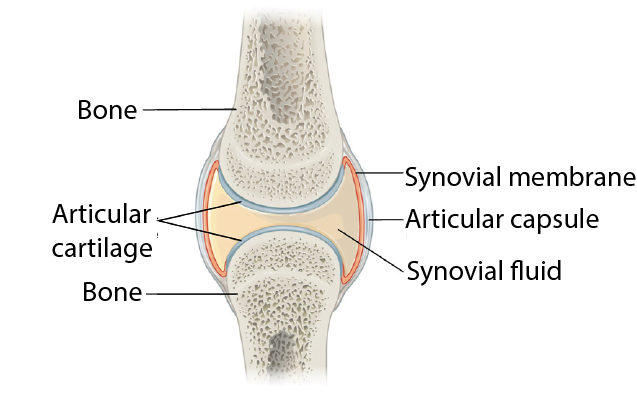
Muscles
A muscle is a band or bundle of fibrous tissue in a human or animal body that has the ability to contract, producing movement in or maintaining the position of parts of the body.
Types of muscle
The 3 types of muscle tissue are
- cardiac located in the heart walls
- smooth muscles in visceral structures under involuntary control. Smooth muscle generally forms the supporting tissue of blood vessels and hollow internal organs, such as the stomach, intestine, and bladder.
- skeletal muscles attached to the bone under voluntary control.
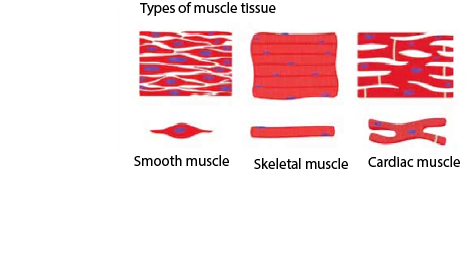
Differences between smooth and skeletal muscles
| Smooth muscles | Skeletal muscles | |
| 1. | Not straited | striated |
| 2. | involuntary | Voluntary |
| 3. | Not under conscious control | Under conscious control |
| 4. | Found within walls of internal organ | Attached to bones e.g. biceps |
Differences between Smooth Muscles and Cardiac Muscles
| Cardiac muscles | Smooth muscle | |
| 1. | Striated | Not striated |
| 2. | Found in heart wall | Found in internal organs |
| 3. | innervated by the autonomic nervous system via its cardiac pacemaker | are directly innervated |
| 4. | do not regenerate | Regenerate when injured |
Differences between cardiac and skeletal muscles
| Skeleton muscle | Cardiac muscle | |
| 1. | controlled by the somatic nervous system | involuntarily controlled |
| 2. | cells are cylindrical in shape | are semi-spindle in shape |
| 3. | are attached to the bone | is found in the heart |
| 4. | skeletal muscle cells are multi-nucleated. |
only one or two nuclei in the cardiac muscle cells |
| 5 | Has no gap junction | Has a gap junction |
| 6 | Few mitochondria | Many mitochondria |
Antagonistic muscles
Muscles responsible for movement by contracting and relaxing against the skeleton are referred to as antagonistic muscles, i.e., when one is contracted the other is relaxed. For example, in human arm when the biceps flex and the triceps extends the arm out.
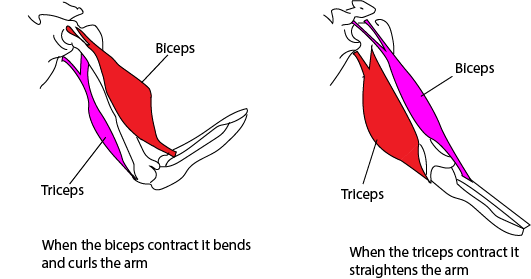
Locomotion
For locomotion in animals three things are required.
-Propulsion; The animals must be propelled with sufficient force in the appropriate direction.
-support; The animal must be supported by its body acting against the particular medium in which it leaves
-Stability; The animal may become temporarily unstable while moving but eventually stability must be restored
Propulsion on land
The legs of land-living vertebrates contain numerous muscle most of which are directly or indirectly involved in propulsion. In propelling the body forward, the most important muscles are the retractors and extensors. When they contract the limb acts a level, lifts the body off the ground and propels the body forward.
Support on land
The limbs hold the body off the ground both when the animal is in motion and when it is standing still. Limbs that are directly beneath the body are more efficient for the purpose.
Stability on land
For a tetrapod at rest, with its four legs planted fairly and squarely on the ground, stability is not a major problem.
During motion, when only three legs are on the ground is when the problem arises. To keep the center of gravity under the triangle of the 3 remaining legs on the ground, the sequence of movement of legs is left hind leg is lifted and brought behind the left forelimb. Then left forelimb is lifted and placed out in front. Then the right hind limb followed by forelimb is also brought forward. For instance, in the tetrapod below
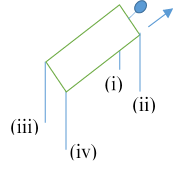
The order of movement of legs is (i), (iv), (ii), (iii) Or (ii), (iii), (i), (iv) or (iii), (i), (iv), (ii),
Locomotion in water.
Water is the densest medium in which living organism can live. It consequently offers a lot of resistance to them. However, the aquatic organisms have adapted themselves in two ways.
1. Have streamlined body to resistance
2. Their bodies are covered with mucus which lubricates the body.
Support in fish.
Bonny fish are made buoyant by gas-filled swimming bladders by adjusting the amount of air in these bladder the fish is able to stay at a required depth.
Cartilaginous fish such as sharks do not possess a swimming bladder of any kind. They sink if they stopped swimming, support comes from the process of swimming itself.
Presence of a swimming bladder makes bony fish better swimmer than sharks
Propulsion in fish.
In most fish propulsion comes from the side -to- side lashing of the tail which is equipped with a caudal fin for increasing the surface area. These movements are brought about by contraction of antagonistic and segmentally arranged muscle called myotomes.
The tail sweeps from side to side by alternate contraction of the myotomes on each side of the body. The myotomes on the left and right side are of course antagonistic and their contractions are coordinated by the CNS.

Stability in fish
A fish is liable to the same kind of instability that affect boats, yawing, pitching and rolling
- Yawing, the side-to-side oscillation of the front part of the body resulting from propulsion action of the tail, is contracted by the general massiveness and inertia of the head and the pressure of water against the side of the body and the vertical fins. In many bony fishes, the stabilizing effect of the feature is enhanced by lateral flattening of the body.
- Pitching the tendency of the front end to plunge vertically downwards, is counteracted by the flap-like horizontal fins. The large the surface area of these fins have, the more effective they are as stabilizers.
- Rolling, the rotation of the body about the longitudinal axis, is counteracted by both the vertical and horizontal fins.
Locomotion in air.
Here the medium provides little support
Adaptive of bird aid flight
- has feathers that aid flight
- hollow bone to reduce weight
- bones are fused to reduce flexibility
- lightweight, smooth feathers – this reduces the forces of weight and drag
- a beak, instead of heavy, bony jaws and teeth – this reduces the force of weight
- an enlarged breastbone called a sternum for flight muscle attachment – this helps with the force of thrust
- a streamlined body – this helps reduce the force of drag
- wings – these enable the force of lift.
- Joints are fused to reduce flexibility
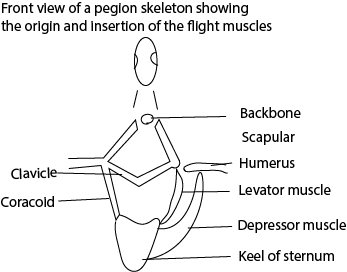
Active flight
The bird flies by flapping the wings.
The large and powerful depressor muscle pulls the wing downwards and give the bird lift during active flight, when the Levator muscle contract it pulls the wing upwards.
The muscle
A whole muscle is made up of hundreds of muscle fibers which vary in length. An isolated fiber is filled with a specialized cytoplasm called sarcoplasm in which about 100 nuclei are spaced out evenly just beneath the bounding membrane or sarcolemma. Numerous parallel striation transverse the fiber from one side to another

The fine structure of muscle
Each muscle fiber contains several hundreds of small units of myofibrils.
When one individual myofibril is observed under an electron microscope the striations are seen as light and dark bands. Each dark band has comparatively light region in the middle and it’s called the H-zone
There are dark regions on either side of the H-zone. Running across the middle of the H-zone is the dark line called the M- line and traversing the middle the light band is an even dark line, the Z- line. The region of a myofibril from one Z line to the next is called sarcomere [the basic unit of the myofibril.
The explanation of the banding pattern is done in the figure below.

The myofibril is composed of numerous longitudinal filaments, the thick and thin ones. The thick filament is confined to the dark band. The thin filaments occur in the light band, but extent in between the thick filaments into the dark band. The area on either side of the H- zone and therefore particularly dark because they contain both thick and thin filaments. The H- zone consists of thick filament only.
Chemical nature of a muscle
It contains two protein actin and myosin. The thick filaments are composed of myosin and the thin filament actin.
How muscle contract
- Skeleton muscle contraction is initiated by the arrival of a nerve impulse at the nerve-muscle junction.
- The arrival of the nerve impulse causes an influx of calcium ions into the pre-synaptic knob leading to release of acetylcholine from pre-synaptic knob into the synaptic vesicle.
- acetylcholine depolarizes the muscle fiber
- the impulse generated thereof is transmitted via T-tubules through sarcoplasm.
- Ca2+ is released from the sarcoplasmic reticulum to the muscle fiber.
- Calcium ions initiate contraction of muscles by binding troponin
- Tropomyosin shift from actin-binding site
- myosin heads get instantly attached to the binding sites on actin filament and contraction of muscles occurs.
Relaxation phase
- After an action potential has cholinesterase is released and breaks down acetylcholine.
- Sarcolemma & T-tubules repolarized
- the calcium gates close, and calcium pumps located on the sarcoplasmic reticulum remove calcium from the cytoplasm.
- As the calcium gets pumped back into the sarcoplasmic reticulum, calcium ions come off the troponin.
- The troponin returns to its normal shape and allows tropomyosin to cover the actin-myosin binding sites on the actin filament.
- Because no binding sites are available now, no cross-bridges can form, Passive sliding of filaments occur and the muscle relaxes.


Greetings doctor Bbosa,l appreciate the good service and kindly requesting for A level locomotion and support coz it has been removed from the website. thanks
done
search “digitalteachers.co.ug/A-level biology notes/locomotion and support”
I’m constantly learning from your posts. Industrial & Scientific
You have a gift for explaining things. Sports News
Understand the required scores through the MBBS Cutoff Of Private Medical Colleges in Punjab.
Learn about the minimum scores for admission at MBBS Cutoff Of Government Medical Colleges in Bihar.
Start playing with added advantages using the Raja Luck Invite Code.
Easily manage deposits and withdrawals directly through the 82 Lottery App.